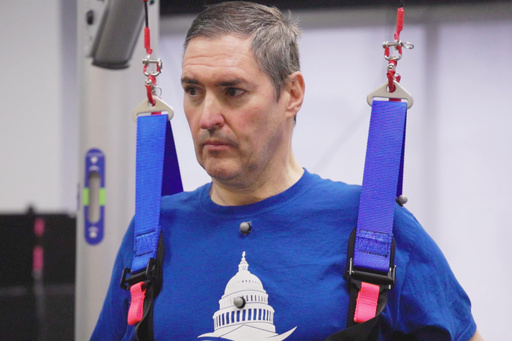Copyright @2024 | USLive | Terms of Service | Privacy Policy | CA Notice of Collection | [privacy-do-not-sell-link]
Home A spinal implant improved walking ability in three individuals suffering from muscle...
WASHINGTON — A breakthrough in neurodegenerative disease treatment has emerged as three individuals suffering from a debilitating muscle condition showed signs of increased strength after receiving a spinal cord-stimulating implant.
Researchers have reported promising results from a pilot study, revealing that this spine-stirring device—which is currently being explored for its potential benefits in treating paralysis—might also have a positive impact on conditions like spinal muscular atrophy (SMA). This surprising development is thought to temporarily restore some muscle function in affected individuals.
“The participants were not anticipating any improvements,” stated Marco Capogrosso, an assistant professor at the University of Pittsburgh and the lead investigator on the research. Over the course of a month-long study, however, the team noticed that the participants were progressively enhancing their abilities.
Spinal muscular atrophy is a genetic disorder that gradually degrades motor neurons in the spinal cord, leading to muscular atrophy, particularly affecting the legs, shoulders, hips, and even muscles responsible for respiration and swallowing. The condition currently has no definitive cure, although there is a life-saving gene therapy available for very young children with a severe form of the disease and medications to slow progression in older individuals.
Low electrical stimulation of the spinal cord has been a common treatment for chronic pain. However, Capogrosso’s team has utilized this method to enable individuals who are paralyzed due to strokes or spinal injuries to regain some independent movement. By delivering electrical impulses, the device activates previously dormant nerve circuits, aiming to stimulate muscle activity.
Inspired by this technology, Capogrosso’s team sought to determine whether similar stimulation could benefit those with SMA by activating sensory nerves that might reenergize damaged muscle cells. In their study, researchers implanted electrodes on the lower spinal cords of three adults diagnosed with SMA and assessed their improvements in muscle strength, endurance, range of motion, walking distance, and gait while the device was operational as well as when it was powered off.
While the implant did not restore normal movement, significant enhancements in muscle function were evident after just a few hours of spinal stimulation weekly, according to the findings published in the journal Nature Medicine.
Study participant Doug McCullough, 57, from Franklin Park, New Jersey, expressed astonishment at the outcomes, stating, “In a progressive disease, any improvement is surreal and incredibly exciting.”
Remarkably, all three participants demonstrated noticeable increases in their walking abilities over a span of six minutes. One individual, who had been unable to rise from a kneeling position at the study’s onset, achieved this feat by the conclusion. Capogrosso noted that McCullough’s strides became approximately three times longer.
“Participants became less fatigued, allowing them to walk for extended periods,” said Capogrosso. “Even individuals in advanced stages of the disease showed improvement.”
Interestingly, the study revealed that the benefits were not immediately lost after the device was turned off, although they gradually diminished during follow-up assessments post-study. McCullough remarked that some nights, even without stimulation, his legs felt “supercharged.”
Despite the device’s removal following the study, he felt disappointed yet hopeful, noting he experienced lingering benefits at his six-week follow-up, though none persisted after six months.
Neuroscientist Susan Harkema, who has conducted groundbreaking research on spinal cord stimulation at the University of Louisville, emphasized that this study, although small and brief, represents a significant conceptual breakthrough. She advocates for further research into applying this technique to a variety of muscle-degenerating conditions.
“The complexity of human spinal circuitry extends beyond simple brain reflexes,” Harkema explained. “This study is a substantial contribution that paves the way for future advancements.”
At the University of Pittsburgh, Capogrosso confirmed that more comprehensive studies are on the horizon, aimed at examining the effects of spinal stimulation in a larger cohort.



